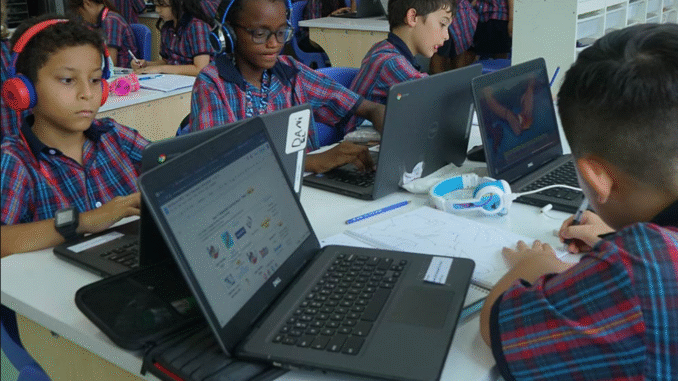
The Power of Digital Tools: Transforming Classrooms in the 21st Century
Introduction
Classrooms have always been places where knowledge is shared, skills are nurtured, and ideas are developed. But in the 21st century, the definition of a classroom has expanded far beyond physical walls and chalkboards. Today, digital tools are reshaping education, making learning more interactive, personalized, and accessible than ever before. From smartboards and tablets to artificial intelligence and virtual reality, technology has become a central part of how teachers teach and students learn.
This digital transformation is not just about convenience—it’s about preparing students for a rapidly evolving world. By equipping learners with modern skills and exposing them to innovative ways of thinking, digital tools are revolutionizing classrooms and creating opportunities for a brighter, more connected future.
A Shift from Traditional to Digital Learning
Traditional classrooms often relied on textbooks, handwritten notes, and one-size-fits-all teaching methods. While these approaches laid the foundation for education, they had limitations in addressing diverse learning needs.
Digital tools, however, provide flexibility and inclusivity. They enable students to learn at their own pace, revisit lessons when needed, and access vast online resources. For instance, a math lesson can now be reinforced through online tutorials, interactive games, and AI-powered apps, allowing students to grasp concepts in multiple ways.
This shift also supports teachers by giving them data-driven insights into student performance. Instead of guessing which students might be struggling, educators can use analytics to pinpoint challenges and tailor instruction accordingly.
The Role of Smart Devices in Learning
One of the most noticeable transformations in classrooms comes from smart devices. Tablets, laptops, and interactive whiteboards have become staples in many schools.
- Tablets and laptops allow students to access e-books, digital assignments, and collaborative platforms. Unlike traditional books, digital materials are interactive, with embedded videos, simulations, and quizzes.
- Smartboards have replaced chalkboards in many classrooms. Teachers can display multimedia presentations, annotate in real-time, and save notes for later review.
- Cloud-based platforms like Google Classroom or Microsoft Teams centralize communication, assignments, and grading, making it easier for students, teachers, and parents to stay connected.
These devices encourage engagement and help students take an active role in their learning, rather than being passive listeners.
Personalized Learning Through Technology
One of the greatest strengths of digital tools is their ability to support personalized learning. Every student learns differently, and technology allows educators to adapt instruction to meet individual needs.
- Adaptive learning software adjusts the difficulty of questions based on student performance. If a learner struggles with fractions, for example, the system provides additional practice and tutorials until mastery is achieved.
- AI-driven platforms can suggest study materials or exercises tailored to each student’s progress.
- Gamification elements, such as badges, points, and leaderboards, keep students motivated and engaged.
By making learning more student-centered, digital tools empower learners to take ownership of their education. This not only improves academic outcomes but also fosters confidence and independence—qualities essential in the 21st century.
Bridging Gaps in Accessibility
Education should be inclusive and accessible to everyone, regardless of background or ability. Digital tools are helping close gaps in learning opportunities.
- Assistive technologies such as text-to-speech software, screen readers, and captioning make learning accessible for students with disabilities.
- Online platforms give students in remote areas access to the same quality education as their peers in urban centers.
- Translation tools help bridge language barriers, enabling students from diverse backgrounds to learn together seamlessly.
By reducing barriers, technology ensures that education is a right, not a privilege, opening doors for students worldwide.
Encouraging Collaboration and Communication
Classrooms are no longer isolated learning environments. Digital tools make collaboration easy, both within a classroom and across the globe.
- Video conferencing platforms like Zoom and Microsoft Teams allow students to interact with peers and experts worldwide.
- Collaborative apps such as Google Docs let students work on group projects in real time, even if they’re in different locations.
- Discussion boards and forums encourage thoughtful dialogue, giving quieter students a platform to share ideas.
These tools mirror the collaborative nature of today’s workplace, preparing students for careers where teamwork and communication are vital.
The Role of Virtual Reality (VR) and Augmented Reality (AR)
Virtual reality and augmented reality are some of the most exciting developments in modern classrooms. They transform abstract concepts into immersive experiences.
- In history classes, students can take virtual tours of ancient civilizations, experiencing them as if they were truly there.
- In science lessons, AR apps allow learners to explore the human body in 3D, rotate organs, and understand complex systems.
- In geography classes, VR can take students on virtual field trips to mountains, oceans, or even outer space.
By making learning experiential, VR and AR boost engagement, memory retention, and curiosity.
The Teacher’s Role in a Digital World
Even as technology advances, teachers remain the cornerstone of education. Digital tools are not meant to replace educators but to enhance their roles.
Teachers act as facilitators, guiding students on how to use technology responsibly and effectively. They curate resources, design creative lessons, and inspire students to think critically. Moreover, teachers model digital citizenship, showing students how to navigate the online world safely and ethically.
Professional development is also crucial. Schools that invest in training teachers to integrate digital tools successfully see better outcomes, as educators feel empowered to innovate in their classrooms.
Challenges of Digital Classrooms
While digital transformation in education has immense benefits, challenges remain.
- Digital Divide: Not all students have equal access to devices or reliable internet connections. This inequality can widen learning gaps.
- Screen Time Concerns: Excessive use of devices can affect health, including eyesight, posture, and sleep patterns.
- Cybersecurity and Privacy: Protecting student data is critical in an increasingly connected world.
- Over-reliance on Technology: Balance is necessary to ensure students still develop interpersonal and offline problem-solving skills.
To address these challenges, schools and policymakers must work together to ensure equitable access, promote digital literacy, and implement safe practices.
Preparing Students for the Future Workforce
One of the key purposes of education is to prepare students for the world beyond school. The workforce of the 21st century demands skills such as digital literacy, problem-solving, creativity, and adaptability.
Digital tools in classrooms mirror real-world technologies, giving students early exposure to the platforms and systems they’ll use in their careers. For example:
- Learning to code or use data analysis tools prepares students for careers in technology and business.
- Collaborating on cloud platforms reflects modern workplace practices.
- Using AI-powered research tools teaches students to work efficiently and critically analyze information.
In short, digital classrooms act as training grounds for the leaders, innovators, and professionals of tomorrow.
Conclusion
The power of digital tools lies not just in making education more efficient but in transforming how students experience learning. By fostering engagement, personalizing education, breaking barriers, and preparing students for the future, technology is shaping classrooms in ways unimaginable a generation ago.
While challenges like the digital divide and over-reliance on screens must be addressed, the benefits of integrating digital tools into education are undeniable. The 21st-century classroom is no longer limited to physical space—it’s a dynamic, connected, and inclusive environment that empowers learners to thrive.
As we continue to embrace innovation, one truth remains clear: digital tools are not just changing education—they are transforming the very definition of learning itself.

